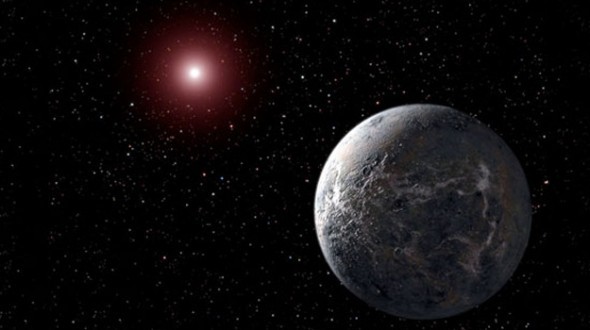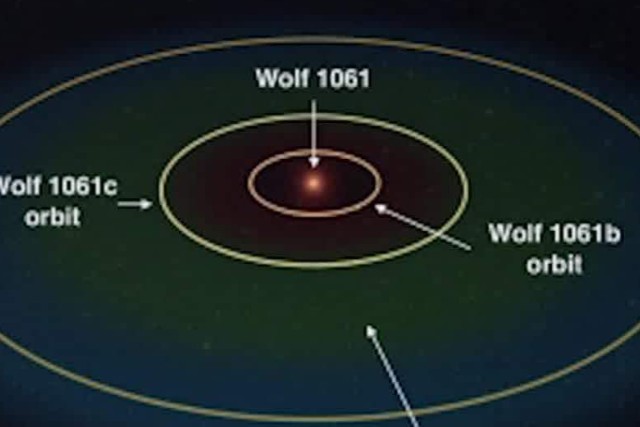The planet, named Wolf 1061c, orbits a star 14 light years away – about a third closer than the next nearest potentially inhabitable planet, which was found in 2013.
It is one of the first times that astronomers have spotted a planet near to us that has the kind of rocky, solid surface that is thought to be necessary for alien life.
“It is a particularly exciting find because all three planets are of low enough mass to be potentially rocky and have a solid surface, and the middle planet, Wolf 1061c, sits within the ‘Goldilocks’ zone where it might be possible for liquid water — and maybe even life — to exist,” said lead study author Dr Duncan Wright in a statement.
“It is fascinating to look out at the vastness of space and think a star so very close to us — a near neighbour — could host a habitable planet.”
Scientists might now be able to catch a view of the planet, helping them study its atmosphere and explore whether it might be able to support life.
The team found three planets going around a star that is stable like our own but smaller and relatively cool. One of the three planets, known as Wolf 1061c, sits squarely within the habitable zone.
The team, from the University of New South Wales (UNSW), made the discovery using the HARPS spectrograph, which is part of the European Southern Observatory’s 3.6 metre telescope in La Silla in Chile.
“Our team has developed a new technique that improves the analysis of the data from this precise, purpose-built, planet-hunting instrument, and we have studied more than a decade’s worth of observations of Wolf 1061,” Professor Chris Tinney, head of the Exoplanetary Science at UNSW group, said in a statement.
“These three planets right next door to us join the small but growing ranks of potentially habitable rocky worlds orbiting nearby stars cooler than our Sun.”
Scientists will now hope that they can explore the planet’s atmosphere in more detail.
“The close proximity of the planets around Wolf 1061 means there is a good chance these planets may pass across the face of the star. If they do, then it may be possible to study the atmospheres of these planets in future to see whether they would be conducive to life,” said team member UNSW’s Dr Rob Wittenmyer in a statement.
Agencies/Canadajournal

 Canada Journal – News of the World Articles and videos to bring you the biggest Canadian news stories from across the country every day
Canada Journal – News of the World Articles and videos to bring you the biggest Canadian news stories from across the country every day



I love what they are discovering but scream when implications of life sustaining planets is inferred. It is just not possible.
My questions are about how you or the Astronomers, can come to the “life sustaining” conclusions by pure scientific logic.
Your representation of the planets are that their orbits are circular like those in our solar system, however, the technique used to find planets at distance, unless they have found a new way which they have not described, is that there is a “wobble” created by the mass center point around which the bodies rotate, which causes the image we are seeing, which is old, to move back and forth in pictures of the sky taken in sequence at different times, and their reference information for this article is from decades of observations, which is creates oblong orbits, since the center point is not in the center of the star/sun of the system, so why do you represent the orbits as circular, that is a deception.
I question this because by nature the orbits being oblong not circular, would mean there are temperature fluctuations already and the “suns” are cooler as well, meaning there is little if any chance of their being an atmosphere much less temperatures consistent enough to sustain any kind of life on the surface. Given the delicate balance our earth provides of Gravity, a sizable moon, also in a circular orbit, the proximity to our sun, it’s solar output, our precise orbital distance from the sun, the mass of the earth to hold the necessary atmosphere, the ability of water to be formed, etc., how can it be postulated that these planets would be remotely habitable, which in my mind means long term. I know you want to draw readers but a better title would be around the new equipment the the scientific efforts, rather than drawing impossible conclusions about life sustaining planets. This system is old news to begin with if they have decades of data from which to find the “Wobble”. The discovery of how to find planets is reasonably new, but the information is old and to get funding it would appear that these scientists are dangling the eternal question generated when man first looked up, about other life in a vast universe, to obtain grants and funding for their new equipment, when the technique will never render results that find habitable planets.
Given what we know about the universe in light of Einsteins theory of relativity, that any body with mass in our universe affects all other masses, all planetary discoveries to date, including this one, have oblong orbits, making OUR solar system unique.
Any speculation to the contrary with current data and how it is gathered is disingenuous given we cannot see any other circular orbit systems because they do NOT create the “wobble” described above.
If you were indeed able to discover a system with multiple planets in circular orbits like ours, that would be extraordinary, not a tortured conclusion that these planets could somehow sustain life of any nature give the violent nature of the ACTUAL orbital dynamics these planet take.
Scientists take herculean efforts to deny the uniqueness of our planet and it’s ability to sustain life, because that would require acknowledging a more plausible theory around design and a “designer”. Every “new” discovery they make supports this conclusion, not the “other habitable planet” theories they come up with to get funding from a secular money pool. It is similar to the resistance against accepting Einstein’s theory over Sir Isaac Newton’s theory of gravity which could not account for the orbital position of Mercury.
What makes more sense if you are intellectually honest is that the entire universe and the subsequent balance created by all of the bodies and their gravity, have made our solar system’s position unique both in a solar system configuration, and the balance of other elements described above, in order to sustain life.
Quantum physics, which deals with the universe at the atomic and sub atomic levels cannot be reconciled with what we observe from Einstein’s theory because Gravity is too week as we observe it in 3 dimensions which is why we know there are more. That said as we delve into the minutiae of the mathematics e=mc(squared) turns in to pages of equations that still don’t reconcile.
The movie interstellar, does a great job of presenting what we currently know based upon Relativity, and briefly points out that it does not reconcile with the Quantum Physics, but to sustain the story line, there are glaring holes in the science, one of which is the colony enabled to leave Earth by the quantum info sent back from the black hole, then ends up orbiting Jupiter or Saturn, ie. one of the super gas giants which both have ridiculous mass/gravity compared to earth, and a fraction of the light due to their distance from the sun, and they represent life in the colony as essentially the same as it was on earth in terms of human activity. The factual representation would have to deal with the enormous effect the increased gravity of the Gas Giant, given the close proximity to the gas giants, would have which would not allow life to exist and how are they providing light sufficient to represent green pastures. A better representation would have had the colony in orbit around the earth.
So if your scientists could provide me with answers outlined in this post I would love to here how they address the biology, physics, astrophysics, and chemistry that could sustain life on any of their discovered planets.
I am sure there are typos etc. there is so much to ask in a short forum and I am tired of editing, but any of the scientists would be interested in a private conversation my email is attached.